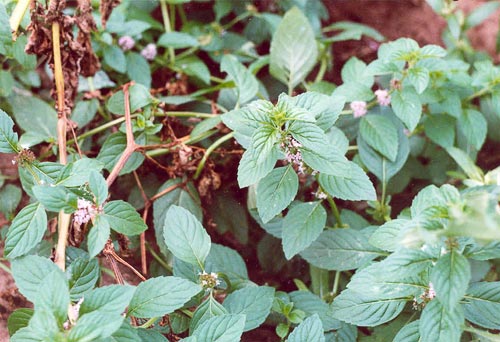Weeds
Mentha arvensis L. - Corn mint.
Systematic position.
Family Lamiaceae Lindl., genus Mentha L.Synonyms.
Mentha lapponica Wahlenb., Mentha parieteriifolia J. Beck.Biological group.
Perennial rhizome weed.Morphology and biology.
Aromatic weed with fleshy surface and underground shoots. Stem dull green, somewhat purple-splotched, prostrate to erect, square, often ramified, 15-50 cm high. Cotyledons broad, rounded triangular. Leaves horizontally opposed, ovate or elliptical, petiolate, slightly serrate to notched along margin. Flowers lilac or rose-lilac; corolla not labial, but funnel-shaped, having dense spherical axillary pseudo-whorls, with short-belled, fivefold slit calyx. Nutlets about 1 mm long, rounded, smooth, light-brown. Flowering in June-September. Produces up to 6400 seeds per plant.Distribution.
Western Europe, the Himalayas, India, China. European part of the former USSR, the Caucasus, Central Asia, Western Siberia, Eastern Siberia.Ecology.
Grows well on sandy and clay loams with periodic water-soaking. Indicator of damp soil conditions.Economic significance.
Weed of grain and tilled crops; occurs in kitchen gardens, fallow lands, along roads and irrigation ditches. Control measures include multiple-field crop rotation, removing stubble, pre-winter plowing, chemical weeding.Reference citations:
Agaev M.G., ed. 1988. Main field-weed plants of the Leningrad Region. The catalogue of VIR world collection, Issue 468. Leningrad: VIR. 68-70. (In Russian)Anonymous. 1996. Weeds on sugar beet. Berlin: Hoehst Schering AgrEvo GmbH. 242 pp. (In German, English, Russian, Ukrainian)
Nikitin V.V. 1983. Weed plants of the USSR flora. Leningrad: Nauka. 314 p. (In Russian)
Shishkin, B.K., ed. 1954. Flora of the USSR. Moscow-Leningrad: AN SSSR. V. 21: 604-605. (In Russian)


